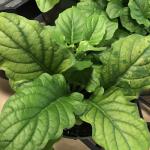
 Gerbera daisies were brought into the UMass Extension Plant Diagnostic Lab this week. These plants displayed two different symptoms. The first was a somewhat blotchy appearance to the lower leaves, with interveinal chlorosis (yellowing of plant tissue in between the veins, which remain green) and small tan spots that expanded over the next few days. The second was a relatively uniform interveinal chlorosis on younger leaves. The pH of the growing medium was 6.4. Upon further investigation and discussion with the grower, the most likely explanation for the symptoms observed is deficiency of both iron and magnesium. Testing is currently being done at the UMass Soil and Plant Tissue Testing Lab to confirm this diagnosis.
Gerbera daisies were brought into the UMass Extension Plant Diagnostic Lab this week. These plants displayed two different symptoms. The first was a somewhat blotchy appearance to the lower leaves, with interveinal chlorosis (yellowing of plant tissue in between the veins, which remain green) and small tan spots that expanded over the next few days. The second was a relatively uniform interveinal chlorosis on younger leaves. The pH of the growing medium was 6.4. Upon further investigation and discussion with the grower, the most likely explanation for the symptoms observed is deficiency of both iron and magnesium. Testing is currently being done at the UMass Soil and Plant Tissue Testing Lab to confirm this diagnosis.
A potential case of iron deficiency was also observed this week in calibrachoa (million bells). Like petunias, gerberas and calibrachoa are iron inefficient and prone to deficiency. Plants require iron in small amounts for the production of chlorophyll. Interveinal chlorosis is the primary symptom of iron deficiency. Because iron is immobile in plants, deficiency symptoms are most evident in younger tissues. Iron deficient gerberas may also be lacking magnesium, which can cause similar interveinal chlorosis and necrosis on the lower leaves. Magnesium is mobile in plants and will be moved from older tissues to younger ones, hence the appearance of symptoms in older leaves.
Causes of iron deficiency:
- The pH of the potting medium is too high. Deficiency may occur in iron inefficient plants if the pH of the medium is > 6.2.
- There is too little iron in the medium or fertilizer solution.
- Root rot is present. A diseased root system may be incapable of adequate nutrient uptake.
- Cool temperatures lower the rate of transpiration, which reduces the rate of nutrient uptake. The optimum temperature for gerberas is 68-70°F.
- The growing medium is too wet. This also inhibits root function and impairs nutrient uptake.
Management:
- Examine plants for root rot. If the root system appears unhealthy, a root pathogen may be present. Be sure to get an accurate diagnosis.
- Test soil pH and adjust pH to 5.8 - 6.2 if necessary. This is most often done with the application of acidifying fertilizers.
- Iron chelates can be used to supply iron if it is lacking in the medium or fertilizer.
- Avoid overwatering.
Further information:
- Angela Madeiras, Extension Educator and Diagnostician, UMass Extension Plant Diagnostic Lab